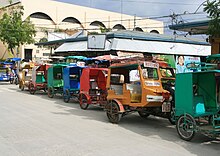Tricycles – a unique, three-wheeled form of transport – are as integral to the Philippines’ transportation ecosystem as jeepneys. For expats navigating their way around the country, tricycles offer a compact and convenient mode of transport. This post explores the world of tricycle transportation for expats, discussing the benefits and drawbacks of this unique transport mode.
What are Tricycles?
In the context of Philippine transportation, tricycles are not what you’d picture when you hear the word. They are motorbikes with an attached sidecar, often vividly decorated, providing a local short-distance travel option. These vehicles have become a staple of Philippine transport, particularly in provincial areas and smaller cities.
The Pros of Tricycle Travel
Affordability
Tricycles offer a low-cost transportation option, especially for short trips. Typically cheaper than taxis and other private hire vehicles, tricycles make for a cost-effective choice.
Maneuverability
Their small size allows tricycles to navigate through traffic and narrow streets with ease. This is particularly beneficial in congested areas, where larger vehicles may struggle.
Local Engagement
Like jeepneys, riding a tricycle provides an intimate look into Filipino life. The conversations with drivers and other locals, combined with the ability to explore off-the-beaten-path areas, make for a rich cultural experience.
The Cons of Tricycle Travel
Limited Space
Tricycles are compact, with the sidecar designed to fit a maximum of two to three passengers comfortably. This limited space may not suit larger individuals or those with certain health conditions. If you are Big and Tall, they can be pretty miserable. There is absolutely no legroom.
Exposure to Elements
Most tricycles do not provide full protection from the weather. This means that during rainy season or in high heat, the journey can be uncomfortable. People with weather-sensitive health conditions or taking certain medications may need to take this into account.
Safety Concerns
As they are open vehicles, there are inherent safety risks, especially during heavy traffic or at high speeds. Moreover, the lack of standard safety features such as seatbelts and airbags is something to consider.
Tips for Riding Tricycles
If you’re planning on adopting these as your transportation of choice, keep the following in mind:
- Carry small change for fares.
- Learn to negotiate fares, as some drivers might charge more to foreigners.
- Protect yourself from the sun and rain – carrying a hat, sunglasses, or a small umbrella can be beneficial.
Conclusion
Tricycles offer a unique and efficient way of getting around in the Philippines. However, like any transportation mode, they come with their own set of challenges. It’s about finding a balance between immersing oneself in the local culture and maintaining a comfortable and safe journey. After all, life as an expat is all about embracing new experiences while making prudent decisions.

